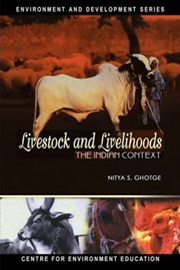Book contents
- Frontmatter
- Foreword
- Acknowledgements
- Contents
- Preface
- Chapter 1 The Beginning …
- Chapter 2 Patterns of Livestock rearing
- Chapter 3 Traditional Practices in Animal Rearing
- Chapter 4 Emerging Trends in Livestock Rearing
- Chapter 5 It must not End: Towards an Alternative Policy
- Chapter 6 Reorienting Ourselves
- Chapter 7 Framework for An Alternate Policy
- References
- Index
Chapter 7 - Framework for An Alternate Policy
Published online by Cambridge University Press: 26 October 2011
- Frontmatter
- Foreword
- Acknowledgements
- Contents
- Preface
- Chapter 1 The Beginning …
- Chapter 2 Patterns of Livestock rearing
- Chapter 3 Traditional Practices in Animal Rearing
- Chapter 4 Emerging Trends in Livestock Rearing
- Chapter 5 It must not End: Towards an Alternative Policy
- Chapter 6 Reorienting Ourselves
- Chapter 7 Framework for An Alternate Policy
- References
- Index
Summary
Framing a policy, even an alternate policy is no easy matter. Ideally, it requires the consensus and participation of a large number of stakeholders. Further, for a livestock policy to be effective, it is equally important that policies governing water, forests, agriculture, land use, energy and environment are effective and in place. Contradictory policies will only defeat each other and negate the effects.
Features of an Alternative Policy
Planning exercises need to be decentralized so that regional features get consideration. Panchayat raj institutions, Village committees, Forest Management committees, Watershed committees etc, are to be involved in the local level planning exercises.
Representation of marginalised communities and women in planning exercises.
Database Management Systems of natural resource to be used for local level planning and decision-making.
Demand and supply studies need to be initiated at the local level to witness flow of resources within the region. This will further help planning and decision-making.
Capacity Building at Local Levels
For effective decision-making at the village level, the capacities of people here will have to be strengthened.
Local Indigenous Knowledge (I.K) systems to be validated in order that they may be used for capacity building. I.K systems in the fields of animal health, nutrition, management, breeding, housing, forest and grassland management need to be carefully documented, validated and used for training and enhancing the capacities of the local people.
- Type
- Chapter
- Information
- Livestock and LivelihoodsThe Indian Context, pp. 122 - 126Publisher: Foundation BooksPrint publication year: 2004



